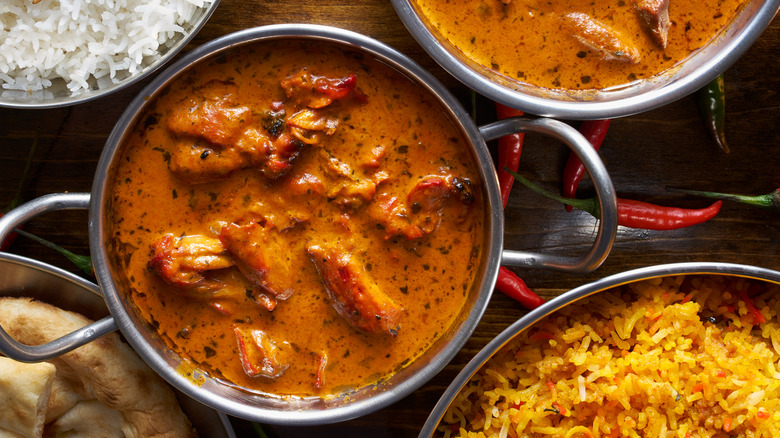Tikka Masala Vs. Butter Chicken: What's The Difference?
When all was said and done, 2022 turned out to be a tough year for British royalty. Elizabeth Windsor passed away, as did Vogue's queen of punk, Vivienne Westwood. Further, on December 19, with less fanfare but no less lasting a legacy, the curry king of Glasgow, Ali Ahmed Aslam, left this mortal coil for the grace and bounty of the great curry house beyond (via The New York Times).
Mr. Ali, as he was known, spent his entire adult life running his restaurant, Shish Mahal. His nephew, Andleeb Ahmed, speaking to NPR, recalled a humble, hardworking restaurateur who was passionate about serving his customers and bringing new flavors into their lives. It is fitting then that this man will go down in history as the inventor of a dish that has opened millions of minds to the joy and possibility of Indian food — the chicken tikka masala.
Aslam's legacy isn't without controversy. Many have issues with the idea that one of the pre-eminent symbols of Indian cuisine worldwide is co-opted by the nation that held India as a colonial subject for centuries (via Goya). Foodies will often point to the other rich, red chicken curry at a similar spice level, butter chicken, or murgh makhani, as being "more authentically Indian" (via Our Modern Kitchen).
The truth is that both chicken tikka masala and butter chicken are, to paraphrase Hua Hsu in The New Yorker, joyfully inauthentic dishes. Their differences and similarities mirror the lives of their creators — Mr. Ali and Kundan Lal Gujral.
The similarities
At the core of both dishes is marinated chicken, roasted in a tandoor oven, which, according to The Times of India, have been found in archaeological digs dating back over 5,000 years. Per The Economist, the first Mughal emperor, Babur, decreed chefs prepare only skewered boneless chicken because he was afraid of choking on bones, which dates chicken breast kebabs to the early 1500s (via Brittanica).
However, in 1920s Peshawar, per The Wall Street Journal, tikka was grilled or fried, and bread was the only thing that tandoors were baking. At Moti Mahal restaurant, Kundan Lal Gujral began using the oven to roast skewers of yogurt-marinated chicken, and this tandoori chicken style began to take off. To call doing something that has been done for thousands of years a new invention is a bit of a stretch, but Gujral was successful enough with his new style of chicken that when India gained independence and was partitioned in 1947, he and his business partner Kundan Lal Jaggi flew to Delhi and opened up Moti Mahal there (via Fodors).
It is there and then, in the late '40s, amongst the aftermath of partition, that butter chicken was born. Whether Jaggi or Gujral was the inventor is debated between their families, but it is clear that this was a dish of diaspora, created by refugees fleeing the new country of Pakistan, opening a grilled-meat restaurant in what was, until then, a predominantly vegetarian city, according to Menu.
Rhyming origin stories
Due to its natural lack of fat, chicken breast dries out quickly (per University of Wyoming). Even with a great yogurt marinade, it happens, as evinced by Ali Aslam and Kundan Lal Gujral having such similar stories for inventing the dishes that made them famous. Both had dry tandoori chicken, and both solved the problem with a rich tomato gravy. Of course, now a world of new recipes has blurred the lines between these dishes, which were never truly formalized anyway. As The Indian Express said, the major difference used to be that butter chicken was cooked on the bone, but that's not even the case anymore! The real difference is in symbolism, beginning with the stories of how the dishes came to be.
According to The New York Times, it was a local Glasgow bus driver at the end of his shift who felt his tandoori chicken was too dry and spicy that set Aslam on the path to the culinary firmament. He whipped up a quick tomato gravy to toss the dry chunks in, called it masala sauce, and thus was born the chicken tikka masala.
Twenty or so years earlier, in Delhi, refrigeration was hard to come by. Cooked tandoori chicken would dry out in the heat and become unsellable. So, per NDTV Food, Gujral made a basic gravy of butter, cream, tomatoes, and spices to rehydrate the meat and cut down on waste.
The real difference
Kundan Lal Gujral and Kundan Lal Jaggi bridged an unimaginable culinary divide, per Vice. They created a middle ground between casual roadside dhabas and silver service European fine dining restaurants in fancy hotels. These refugees set up a chicken shop that pioneered middle-class Indian restaurants for Indian people. Per Indian Express, they went on to host not just Nehru and Indira Gandhi, the first and third prime ministers of India, but John F. Kennedy, Richard Nixon, and even the shah of Iran! The Restaurant Times reports that Moti Mahal now has over 120 locations, and The Hindustan Times said, "eating butter chicken in Moti Mahal is like reading Shakespeare's 'Hamlet.'"
Peshawar, Gujral's hometown, is about 230 miles from Lahore, near Ali Aslam's birthplace. The Hindu Gujral family left for India in 1947, whereas the Muslim Aslam family stayed another decade before heading to Scotland, where Aslam's father opened the first "proper" Indian restaurant in Glasgow in 1959, according to The Herald. The Aslams and families like them changed the face of British food.
Dry chicken. Tomato gravy. Immigrant families selling a taste of their homeland in a new place. Humble cooks earning the adoration of nations. Perhaps there's value in debating their differences, but maybe the best way to honor the memory of Mr. Ali is to think of them as two doors in the same gateway. A gateway of flavor flung open forever by these men and their hospitality.



